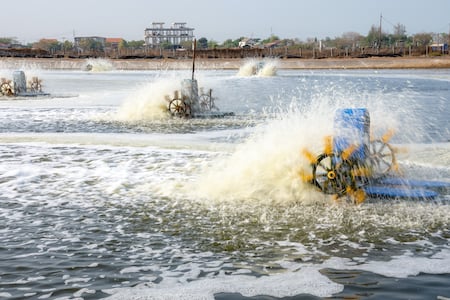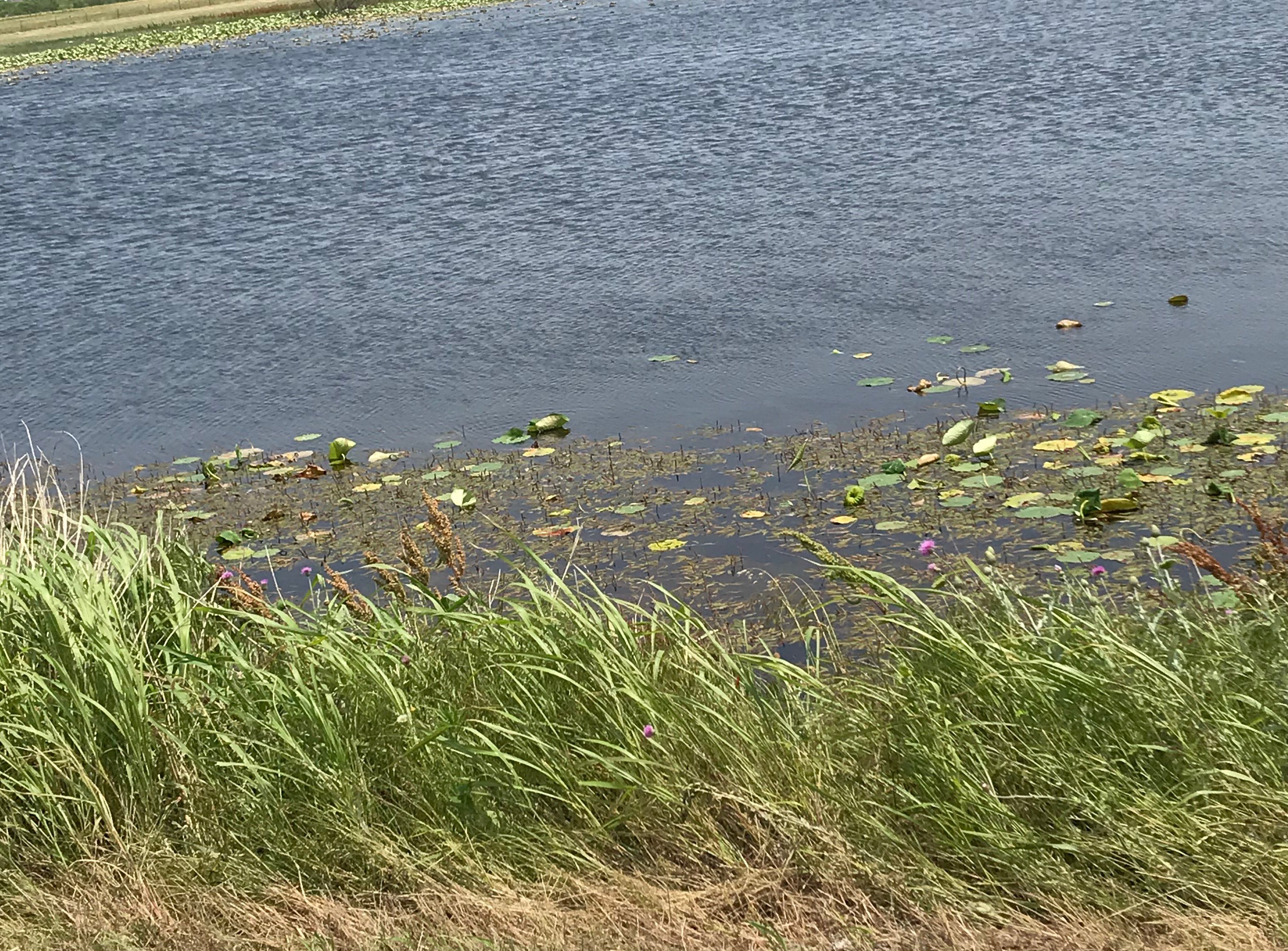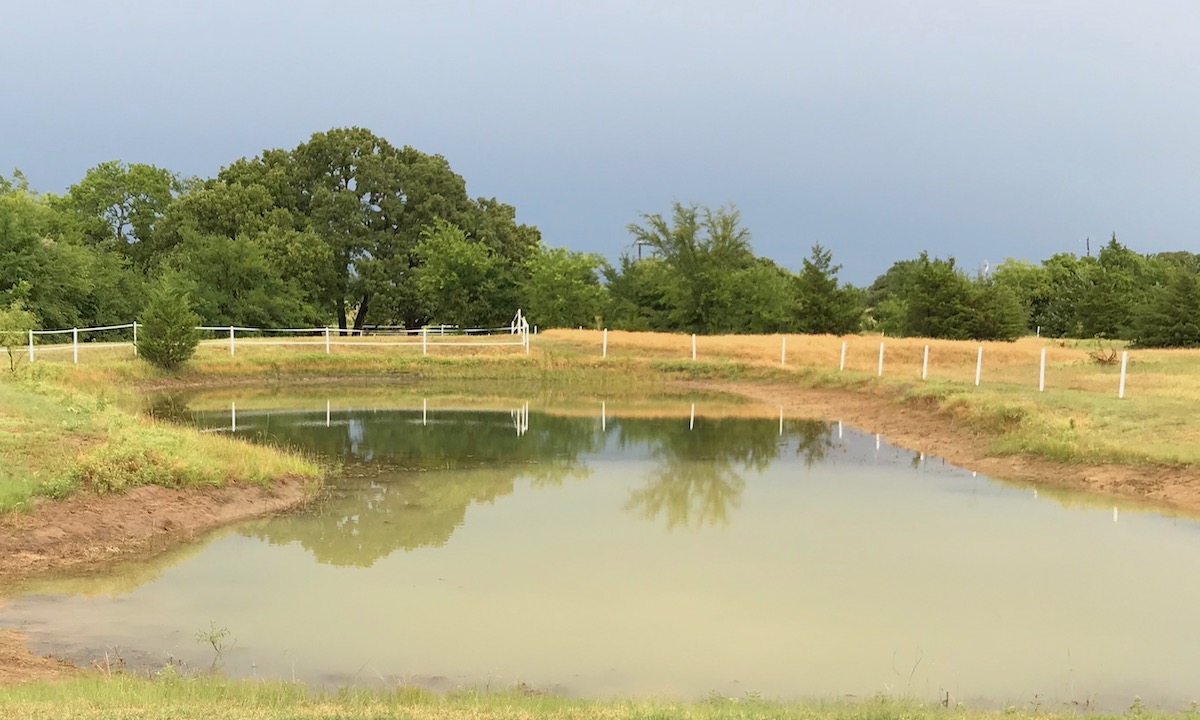The extreme heat and severe storms associated with summers in Texas can be hard enough on us humans in our day-to-day lives, but it can also wreak havoc on the fish in your lake or pond.
The professionals at Pond King have decades of experience managing ponds and lakes in Texas and can help you protect your investment from these weather events.
How Excessive Heat and Severe Storms Hurt Your Fishery
It is no secret that you will face extreme heat and possibly severe storms throughout the summer months when you live in Texas or any southern state.
While this weather can be hard on us in our day-to-day lives, it can also be tough on the fish in your lake or pond. An effective management plan addresses these weather conditions by establishing preventative measures to lessen their impact.
Let's take a look at what steps you should take to prepare your lake or pond for these weather events.
Extreme Heat
The most obvious challenge of summer is the extreme heat, and often drought that can come with high temperatures. There are a couple serious factors that should be considered heading into a hot summer.
Evaporation
The summer heat has a significant impact on any body of water, but even more so on smaller bodies of water.
In the summer, lower humidity and prolonged exposure to sunlight (longer days) increase your pond's evaporation rate. The increase in evaporation immediately draws concern to decreasing water levels in the pond. In areas with minimal average rainfall, the evaporation will be much more prominent and observable.
In shallow ponds, the possibility of drying up is a genuine concern.
In most parts of the country, we rely on periodic rain to replenish the water lost to evaporation to prevent a pond from drying up. However, if you live in an arid environment or an area prone to droughts, you should consider other more predictable options.
Prepare a New Pond with a Deep Water Pocket or Channel
If you are building a pond or lake where maintaining water levels may be difficult, the best preventative measure is to create a significant deepwater area in the main body of the lake or pond with deeper channels leading up into the arms/pockets.
These deep areas will help ensure you have sufficient water volume to support your fish through the summer, even if you lose several feet of water to evaporation.
Additionally, the deep channels leading to the arms and pockets will help ensure the pond stays interconnected at low water stages and helps to prevent fish from being left high and dry as water levels fall.
Pumping In Water is Ideal for Existing Ponds and Lakes
If you've got an established lake or pond, digging out deeper areas isn't a viable option.
Instead, consider replenishing lost water by pumping water in from another source. This external source might be a well, or in some instances (pending proper and legal approval), it could be surrounding streams/rivers.
While starting a pump and opening a valve is a relatively convenient way to keep a pond filled, you need to keep in mind a couple of things.
Things to Consider When Pumping in “Fresh” Water to a Pond
Water from an underground water table often has a deficient dissolved oxygen concentration and, at heavy concentrations, can be very harmful.
To add poorly oxygenated water without lowering the dissolved oxygen levels of your entire pond, use a slow flow rate or consider spraying the water in from above your pond's waterline. This will allow oxygen to diffuse into the water before entering the pond.
If you plan to pump water from another source, our preferred option is another surface-level waterway because that water typically has a sufficient dissolved oxygen concentration.
We recommend spraying this water in from above to minimize the risk of lowering the dissolved oxygen levels too much.
A unique challenge we've observed with this type of system is unintentional nutrient loading leading to nuisance vegetation growth. When pumping water from one nutrient-rich environment to another, especially a shallow one, an increase in vegetation growth is possible.
This excessive growth can compound the evaporation issue because the vegetation will consume oxygen, depleting the dissolved oxygen levels of the limited water volume.
Dissolved Oxygen Concentrations
Optimal dissolved oxygen concentrations are critical to fish and aquatic organisms' survival. As dissolved oxygen concentrations decrease, fish and organisms begin to experience environmental stress.
In response to this stress, they'll become lethargic, slowing their metabolism to lessen their need for oxygen. This environmental stress contributes to poor growth rates and, in some cases, mortality.
How to Optimize Pond and Lake Oxygen Levels in Summer
To ensure optimal levels, you can diffuse oxygen into the water in a few different ways.
You can add oxygen directly through supplemental aeration systems or as a byproduct of photosynthesis from aquatic plants and photosynthetic organisms such as phytoplankton.
The Optimal Dissolved Oxygen Concentration for Largemouth Bass
For Largemouth Bass (Micropterus salmoides), a dissolved oxygen concentration greater than 5.0 ppm is optimal for a healthy bass population. While their actual critical concentration for survival is less than 5.0 ppm, a concentration level below this number significantly impacts the condition of the fish.
By manipulating surface diffusion and aquatic plants, we can ensure oxygen concentrations remain adequate for bass production.
Aerate Your Private Pond or Lake with Fountains or Surface Diffusers

Consider using surface aerators or aerating fountains to increase and maintain dissolved oxygen concentrations above the 5.0 ppm threshold.
These fountains pump water from the lake into the air in tiny water droplets, thus vastly increasing the surface area for diffusion while also increasing exposure to atmospheric oxygen. Any means of expanding the water's surface area and exposure to atmospheric oxygen can significantly increase dissolved oxygen concentrations within the pond.
In fact, you'll often see fish farms using paddle wheels to agitate the water's surface to increase diffusion into their ponds.
You can also use aquatic vegetation in proper densities to help replenish oxygen.
A few of the beneficial aquatic plants Pond King’s biologists use include:
- American Water Willow
- Sedges/rushes
- Duck Potato
- American Pondweed
These plants replenish oxygen through photosynthesis while providing valuable habitat and shade for fish during the hot summer months.
Now, you might be inclined to think the more vegetation, the more oxygen; however, that is not always true. During the day, yes, there will be more oxygen produced. But at night, the plants begin to use oxygen from the environment to undergo cellular respiration to break down further and gain energy from the glucose produced during photosynthesis.
High densities of aquatic vegetation (especially submergent) can deplete oxygen concentrations overnight through consumption during cellular respiration.
The Right Ratio for Aquatic Vegetation in Ponds and Lakes
For this reason, we recommend keeping at least 50% of your pond's surface area free from vegetation. Maintaining beneficial vegetation at around 15-20% of the pond surface area is much healthier, allowing for increased oxygen concentrations and providing suitable summer habitat for fish.

New Ponds and Lakes Should be Built with Oxygen Replenishment in Mind
When building a pond, choosing a location where it will receive frequent wind to create waves on the surface is a big help to replenish oxygen naturally. The shape of the ripples and waves created by the wind increases the surface area for oxygen to diffuse 24/7.
This natural diffusion is constantly adding oxygen into the water and is especially helpful at night when there isn't any oxygen being produced from photosynthesis. This extra step in planning your pond location is another way to manipulate surface diffusion to deliver more oxygen.
Severe Storms
In Texas, when we talk about severe storms, we are primarily referring to rainstorms and thunderstorms. These storms can drop large volumes of water very quickly, which can be great when you are trying to fill a newly built reservoir but could be detrimental to an existing lake or pond.
The two most significant concerns with severe rainstorms of this type are induced turnover and cold shocking your fish.
Induced Turnover
During the summer, lakes, and ponds with water depths of 10 feet or more often stratify into three non-mixing layers:
- Epilimnion refers to the surface layer of water, which has readily available oxygen concentrations and is the hottest and least dense.
- Metalimnion describes the middle layer of the pond, with depleted oxygen levels, and where the temperature decreases more rapidly with depth than anywhere else in the water column.
- Hypolimnion pertains to the bottom layer of the lake, where there is little to no dissolved oxygen and is the coolest and most dense.
In the fall, these layers undergo a turnover.
As the top layer (epilimnion) cools down, it slowly sinks, pushing the middle and bottom layers (metalimnion and hypolimnion) towards the surface. This seasonal transition occurs at a slow pace. Even so, it puts fish in a weird period of slow movement as un-oxygenated water suddenly invades their portion of the water column.
When this turnover happens at its usual slow pace, it's no big deal, but it can lead to increased stress and mortality for many fish when it occurs rapidly - as it does in an induced turnover.
When a severe rainstorm suddenly drops a large amount of cool water into your pond, that deluge can "induce" a turnover by cooling the epilimnion too quickly - causing it to sink abruptly. This induced turnover rapidly pulls the un-oxygenated water to the surface layers, leaving the fish gasping at the surface, trying to get oxygen, and sometimes causing a fish kill.
Ways to Prevent a Turnover On Your Fishery
There are two ways to prevent an induced turnover on your lake.
One way is with size: the larger the lake, the less likely this will happen to your fishery. But, let's face it, you may not be able to do much about that.
For most privately owned fisheries, the easiest way to prevent an induced turnover is to prevent lake stratification altogether.
You can do this by ensuring the layers of the lake are constantly mixing. In shallow lakes (<10 feet), the wind often stirs the water enough to mix the layers. However, in larger, deeper lakes, the wind is unable to churn the entire water column. Bottom aerating diffusers can be used in these deeper lakes to create an updraft of water from the bottom to the surface.
This upwelling of water effectively stirs the water column and helps to prevent any stratification. This upwelling brings water to the surface that would otherwise not be agitated by the wind, thereby oxygenating all portions of the water column.
By continually mixing these layers and oxygenating the entire water column, you can prevent the harmful effects of an induced turnover due to severe rain.
Cold Shock
If your pond or lake is shallow enough that stratification and induced turnover aren't an issue, you might be thinking you're out of the woods. But for ponds and lakes with a shallow profile, cold shock from severe rainstorms could be a problem.
What is a Cold Shock?
Cold shock occurs when a large volume of cool rain rapidly cools the entire water column. This rapid cooling triggers physical and behavioral changes/responses in fish and can even lead to mortality.
Shallow bodies of water, especially those within a large watershed, are particularly at risk of a cold shock event. There are a couple of reasons for this.
The first is because the water temperature is relatively uniform and does not vary much with depth. The second part of this is because there is simply a lower volume of water in the lake, so the temperature can change more rapidly and easily than in lakes with greater volume.
Together this means that the entire water column can change temperature much more rapidly than other bodies of water. Rain and runoff from the storm rapidly cool the whole water column from surface to substrate, exposing the fish to a rapidly changing environment inducing stress and, in some cases, mortality. Rapid temperature changes of as little as 10 degrees Fahrenheit during the summer can be potentially lethal for many fish species.
How to Prevent Cold Shock During Summer Months
Prevention for cold shock events focuses on slowing the temperature change within the water column. A temperature change experienced over 24 hours will be much less stressful and have a significantly lower mortality rate than if that same temperature change occurred in just 2 hours.
To slow the temperature change, you must restrict the rain/groundwater influence into the pond. Since you cannot prevent the rain that falls directly into the water, you are left to slow the runoff.
Creating wide buffers around the pond with beneficial grasses will help divert surface runoff and provide opportunities for runoff to be absorbed into the root systems before reaching the pond. In the feeder arms of your lake or pond, establishing beneficial aquatic vegetation such as American Water Willow, Spike Rush, or sedges in the backs of these arms will help to slow incoming water.
Slowing the incoming current helps keep any rapid change in temperature localized, minimizing the effects of cold shock. Cold shock events are difficult to prevent because you can't control the amount of rain that falls into your pond or watershed; you can only influence the amount of runoff into the pond using these buffers.
These events are not terribly common, so sometimes the best plan is to try to localize these events to only small portions of the pond, allowing fish the opportunity to retreat to more stable parts of the pond, thus reducing mortality rates.
When it comes to managing lakes and ponds in extreme weather, there are a few key points to keep in mind.
- You will lose water through evaporation during periods of intense heat.
-
- Ensure you have enough water in your lake must be enough to withstand the loss, or you plan to find another way to supplement the lost water between rains.
- Maintain greater than five ppm of dissolved oxygen concentration to maintain the fish condition and reduce environmental stress on your fish throughout the summer.
- Choose surface aerators or aerating fountains for shallow lakes and bottom diffusers to break up the thermocline and cycle water in deeper lakes.
- Prevent induced turnover and cold shocking events caused by severe storms. Avert turnover by disrupting stratification and maintaining mixing throughout the different water layers using bottom diffusers.
- Since you can't control the amount of rain that falls into your pond, the best you can do to protect your fish from a cold shock event is decrease the velocity of runoff with buffer zones and isolate the temperature changes to small portions of the pond.
The Pond King Team Can Help Manage Your Pond Through Texas Weather!
These tips will help you prepare for some of the severe weather we are likely to encounter throughout a Texas summer.
If you have any more questions about dealing with extreme heat or storms, feel free to contact us or give our team a call, we'll be happy to help!
See ya'll down at the pond!




